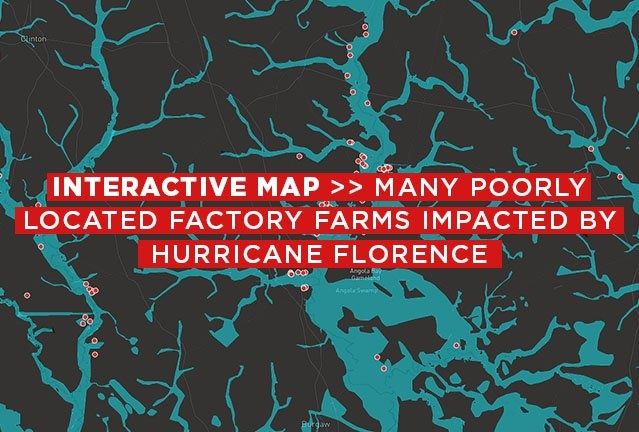
Hurricane Florence Flooded Poultry Operations Housing 1.8 Million Birds, Investigation Finds

Poultry CAFO, September 18. Emily Sutton / Haw Riverkeeper
The heavy rains and high waters after Hurricane Florence flooded 35 industrial poultry operations in North Carolina housing an estimated 1.8 million birds, according to a new investigation by Waterkeeper Alliance and the Environmental Working Group (EWG).
The analysis details how the swine and poultry industry, in the absence of smarter regulation, is not only repeating mistakes, it’s compounding them. For instance, 18 of the industrial swine or poultry operations either surrounded or inundated by Florence floodwaters were flooded by Hurricane Matthew, in 2016. And of the 35 industrial poultry operations confirmed flooded, nine were new operations that had been built following flooding by Hurricane Matthew.
The groups released an interactive map, available here, showing the location of industrial animal operations in the state where waste pits or piles were either flooded, breached or surrounded by floodwaters after Hurricane Florence. The new report is an update to the Fields of Filth investigation the groups produced in 2016, and the follow-up in the aftermath of Hurricane Matthew, when EWG and Waterkeeper Alliance documented 36 swine and poultry operations hit by flooding.
Flooded poultry operations pose a significant environmental threat, as poultry operations are North Carolina’s largest and fastest growing source of nutrient pollution, according to a 2017 report from the state’s Department of Environmental Quality. North Carolina’s poultry industry produced 56.6 million pounds of plant-available nitrogen in 2014, according to the state’s report. That was three times as much nitrogen that year as the state’s swine industry, which is second in size nationally only to Iowa’s. North Carolina’s poultry produced 79.8 million pounds of phosphorus in 2014, six times more phosphorus than the swine industry.
The North Carolina poultry operations that flooded during Hurricane Florence generated an estimated 22,525 tons of waste a year, according to EWG.
The groups will be doing regular testing of water quality in the coming months, and anticipate releasing a followup report in 2019.
“There’s no permitting system for poultry in North Carolina, so the state doesn’t know where these operations are located,” said Christian Breen, a field investigator with Waterkeeper Alliance. “No one did the due diligence to say, ‘Is this really a good place to build them?'”
Soren Rundquist, director of spatial analysis at the Environmental Working Group, said that through his work examining satellite images and geotagged aerial photographs following Hurricane Florence, “I’ve already located hundreds of poultry operations that have been built in North Carolina since Hurricane Matthew hit. Despite the overwhelming evidence that allowing new facilities to be built will result in more flooding and more pollution, regulators are turning a blind eye to the problem.”
Waterkeeper Alliance and the Environmental Working Group used geotagged aerial photographs, high-resolution satellite imagery, a state database of hog operation locations and an earlier Waterkeeper Alliance investigation of poultry locations using satellite imagery to identify hog and poultry operations. The groups used an algorithm based on the state’s formula to estimate the number of animals the operations house.

 233k
233k  41k
41k  Subscribe
Subscribe 
